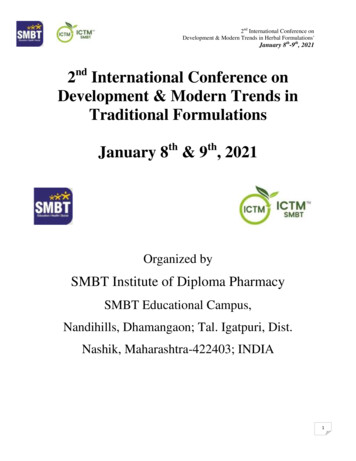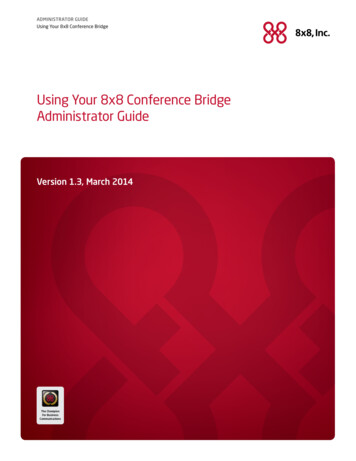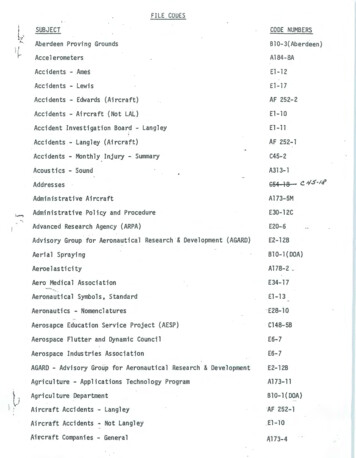
Transcription
2nd International Conference onDevelopment & Modern Trends in Herbal Formulations'January 8th-9th, 20212nd International Conference onDevelopment & Modern Trends inTraditional FormulationsJanuary 8th & 9th, 2021Organized bySMBT Institute of Diploma PharmacySMBT Educational Campus,Nandihills, Dhamangaon; Tal. Igatpuri, Dist.Nashik, Maharashtra-422403; INDIA1
2nd International Conference onDevelopment & Modern Trends in Herbal Formulations'January 8th-9th, 2021ICTM 2021SCIENTIFICPROCEEDINGS2
2nd International Conference onDevelopment & Modern Trends in Herbal Formulations'January 8th-9th, 2021ContentsSr. No.Particulars1Welcome Message2Committee Members3Scientific Program4Table of Paper Presentation5Table of Poster Presentation6Speakers AbstractsPageAbstracts of Paper PresentationAcademician/ Reaserch Scholars Category7(AP-01 to AP-)Student Category(AP01- to AP-19)Abstracts of Poster Presentation8Student Category(SPO-01 to SPO-39)9Author Index3
2nd International Conference onDevelopment & Modern Trends in Herbal Formulations'January 8th-9th, 2021Welcome MessageDear all Delegates and ParticipantsSMBT is pleased to welcome all the participants from different states and various countres toattend 2nd t International conference on „Development & Modern Trends in Herbal Formulations‟during January 8th and 9th, 2021 at Nashik, India. The theme of the conference is “Exploringquality assurance and phytochemical research in traditional medicine which practiced fortreatment and healing” This ICTM 2021 deals with the current research developments in the fieldof Traditional Medicine and also about the new treatment methods which are devised byscientists to treat various diseases in an easier way. These formal get together acts as a bestplatform for participants to learn about the recent trends in quality assurance and phytochemicalresearch and development in traditional medicines.The ICTM 2021 is focuses on recent research an development on Traditional Medicine andclinical study of herbal medicines. The session are emphasized on1. Traditional medicines- sources & clinical application2. Quality assurance 0f Traditional Medicine3. Phytochemistry – isolation and use of active principles.4. Trade of natural products and Traditional Medicine5. Biological screening of natural medicines.6. Herbal FormulationsEight lectures will be presented by distinguished scientists. The researchers will be able to reporttheir research finding in --- paper presentations and --- poster presentations. ----posterpresentation awards and -- paper presentation awards will be presented each to -- academician/research scholar and -- students.We would like to thank to the SMBT management for their help and encouragement during thepreparatory stage of the conference. Our grateful thank for the scientific committee forprocessing abstracts and proceedings book in time. Our special thank for the organizingcommittee who have done their most to offer a successful and satisfying conference.4
2nd International Conference onDevelopment & Modern Trends in Herbal Formulations'January 8th-9th, 2021We wish you all a fruitful conference which strengthen friendship and traditional medicine. Wehope everyone enjoy their stay in Nashik and take home new scientific knowledge andinspiration. SMBT Educational Trust5
2nd International Conference onDevelopment & Modern Trends in Herbal Formulations'January 8th-9th, 2021Dr. Yogesh V. UshirProgramme chair,Principal, SMBT Institute of D. PharmacyOrganizing Committee MembersMr. K.A. SuryavanshiMs. B.D. TambeMr. K. J. TiwariMr S.R.KocharMs. S.T. Garud6
2nd International Conference onDevelopment & Modern Trends in Herbal Formulations'January 8th-9th, 2021ICTM 2021 ConferenceScientific Program Schedule08th January 2021Sr.No.1Time09.00am To09.30amVenue- Zoom Meeting appActivityInaugural FunctionAssoc. Prof. Hazrina Binti Ab. Hadi2309.30 to 10.30am11.00pm to12.00pmDept of Pharmaceutical Technology,International Islamic University, MalaysiaDr. Fredrick Nwude EzeFaculty of Pharmaceutical Sciences, Prince ofSongkla University, ThailandTopic----Ancestral wound healingtreatment in modern applicationTo isolate or not to isolate: Theincreasing relevance of bioactiveenriched natural extracts4512.30pm to01.30pm02.00pm to04.30pmDepartment of Health, Malahayati University,IndonesiaTo analysis of risk factors forobesity in the academiccommunity of university ofMalahayati in 2020e-Poster/ e-Oral Presentations----Assist. Prof. Slamet Widodo7
2nd International Conference onDevelopment & Modern Trends in Herbal Formulations'January 8th-9th, 2021ICTM 2021 ConferenceScientific Program Schedule09th January 2021Sr.No.1Venue- Zoom Meeting appTimeActivityTopic9.00am ToAssoc. Prof. Farahidah Binti MohamedHepatoprotective effect of10.00amFaculty of pharmacy, International IslamicUniversity, MalaysiaParacetamol-HoneysuspensionDr. Rajendra Gyawali10.30am to211.30am12noon to31.00pm42.pm to 4.30pm54.30pm to5.00pmJeju National University,South Korea (PDF)Kathmandu University, Dept of Pharmacy,(Assoc. Prof.)NepalPlant based traditionalmedicines of NepaleseHimalaya: Ethnopharmacologyand formulationAssist. Prof. Sherif Babatunde Adeyemi,University of Ilorin, Ilorin, NigeriaHerbal Medicine for DiabetesMellitus Treatment: Status andProspectse-Poster/ e-Oral Presentations-----Valedictory8
2nd International Conference onDevelopment & Modern Trends in Herbal Formulations'January 8th-9th, 2021Table of Paper PresentationFriday 8th January, 2021Time: Academician/ Reaserch Scholars CategoryCodeAP-01TimeTitle3.30pm to 3.37pm Pharmacognostic Investigation of Tectona grandis Linn. BarkMs Sunita AhireAP-023.40pm to 3.47pm HPTLC Analysis and Force Degradation Study of TapentadolHydrochloride in Bulk and Its Pharmaceutical Formulation- Mrs Asmita SakoreAP-033.50pm to 3.57pm Formulation of PPAR-gamma agonist as surface modified PLGAnanoparticles for non-invasive treatment of diabetic retinopathy:in vitro and in vivo evidences- Mr Umesh LaddhaAP:- Academician/Research Scholar PaperCodeTimeAPO-014.00pm to 4.07pmTitleReview Of Various Dosage Forms And Drug Development InTraditional Ayurvedic MedicineMr Ankush GunjalAPO-024.10pm to 4.17pmEvaluation of Wound healing Potential of Dendrocalamus StrictusLeaf Extracts on Animal Model- Ms Dipali ShelkeAPO-034.20pm to 4.27pmAssessment of Memory Enhancing Potential of Dendrocalamusstrictus Leaf Extracts- Mr Akshay DaswadAPO-044.30pm to 4.37pmStability Indicating Bioanalytical Rp-Hplc Method DevelopmentAnd Validation For Estimation Of Carvedilol-Mr. Agasti L.WareAP:- Academician/Research Scholar Poster9
2nd International Conference onDevelopment & Modern Trends in Herbal Formulations'January 8th-9th, 2021Students CategoryCodeSO-01TimeTopic3.30pm to 3.37pm Determination of Quercetin in Green Tea (Camellia sinensis) for PhytoTherapeutic Applications- Mr Saurabh SonarSO-023.40pm to 3.47pm Genotoxicity of Drugs: Mechanisms, Testing Guidelines and Methods forEvaluation- Ms Leena ShindeSO-033.50pm to 3.57pm Development, Optimization And Evaluation Of Lipospheres Of CelecoxibMs Snehal TidkeSO-044.00pm to 4.07pm Formulation of Epalrestat Microsphere as modified release drug deliverysystem for management of Diabetic MellitusMs Vaibhavi ManoreSO-054.10pm to 4.17pm Development Of Multi-Unit Alginate System: Effect OfAdditives On Indomethacin Release-Ms Mayuri SaladeSO-064.20pm to 4.27pm Formulation and evaluation of buccal patches of Venlafaxinehydrochloride- Ms Ashwini DokhaleSO-074.30pm to 4.37pm Stability-indicating HPLC method for estimation of mebeverine HCl:characterization of its major degradation product and assessment of its insilico profiling to ascertain pharmacokinetic, therapeutic and toxicologicalproperties- Ms Sonam MaliSP:- Students Paper10
2nd International Conference onDevelopment & Modern Trends in Herbal Formulations'January 8th-9th, 2021CodeSPO-01Time3.30pm to 3.37pmTitleTraditional medicines sources and clinical applications (Cinchona)Mr Rehan ManiyarSPO-023.40pm to 3.47pmTransdermal drug delivery by ethosomes- Ms Muskan ManiyarSPO-033.50pm to 3.57pmNatural Products As A Source Of Eco-friendly Immunity BoostingCompounds- Ms Komal ZankarSPO-044.00pm to 4.07pmMedicinal Plant Used In the Treatment of AIDSMr Bhaiyyasaheb WadateSPO-054.10pm to 4.17pmPharmacological Review On Ficus Glomerata- Ms ShubhangiKambleSPO-064.20pm to 4.27pmPharmacogonostical study Of Benincasa Hispida Plant – ReviewMs Chaitali WaniSPO-074.30pm to 4.37pmMartynia annua: a Review- Ms Ashwini BankarSPO- Student Poster11
2nd International Conference onDevelopment & Modern Trends in Herbal Formulations'January 8th-9th, 2021Table of Paper PresentationSaturday 9th January, 2021Academician/ Reaserch Scholars CategoryCodeAP-04Time2.00pm to 2.07pmTitleSynthesis and evaluation of ol-2-yl)methyl)-7methyl-2H-chromen-2-one as anti-tubercular agentMs Monika KakadiyaAP-052.10pm to 2.17pmMarma Therapy in the Management of chronic painMs Shilpa BadheAP-062.20pm to 2.27pmDevelopment of Nanostructured lipid carriers loadedwith Corosolic acid: An efficient carrier forAntidiabetic Effects- Ms Swati RaysingAP:- Academician/Research Scholar Paper12
2nd International Conference onDevelopment & Modern Trends in Herbal Formulations'January 8th-9th, 2021ICTM 2021Speakers Abstracts13
2nd International Conference onDevelopment & Modern Trends in Herbal Formulations'January 8th-9th, 2021Plant based traditional medicines of Nepalese Himalaya:Ethnopharmacology and formulationDr Rajendra GyawaliDepartment of PharmacyKathmandu University, Dhulikhel NepalE-mail: gyawali@ku.edu.npABSTRACTNepalese Himalaya has a rich tradition of plant-based knowledge on healthcare management.Traditional botanical medicine is the primary mode of healthcare for most of the population ofthis district and traditional practitioners.A large number of plants, plant extracts, pastes and plantpowders are used by tribals and folklore traditions in Nepal for treatment of several type ofdiseases. Bioassay analysis of very few plant species have been conducted to investigate andvalidate their medicinal properties, and to ascertain safety and efficacy of traditional remedies ofNepal.The present paper thus attempts to collect our research activities based on theethnobotanical knowledge for treatment by tribals and folklore practices prevailing in Nepal andtheir scientific validation. Biological activities of the several medicinal plants has been carriedout and developed into different doses forms such as tablet, capsule, ointment, cream, gel,microsphere, transdermal patches etc by taking knowledge of long history of herbal usage for theclinical management of a variety of diseases in indigenous cultures on Nepal. The majorpharmacological strategies such as phytochemical and antimicrobial screenings, antioxidant,wound healing, analgesic, antidiabetic, anti-inflammatory etcpropertiesof plants have beencarried out in the discovery of herbal formulation of potential clinical value. Synergy assessmentof essential oil with allopathic drug was also carried out to overcome the resistance ofdifferent pathogens to modern antibiotics. Several of the medicinal plants showed the positiveresults on pharmacological activities according to traditional practice. Mango and orange14
2nd International Conference onDevelopment & Modern Trends in Herbal Formulations'January 8th-9th, 2021peelshowed remarkable results in cancer cells, which could be a very potential anticancer agentagainst human cervical carcinoma and gastric carcinoma and cervical carcinoma bothrespectively. Diploknemabutyracea seed oil and its formulated 5% ointment showed significanteffect as analgesic, anti-inflammatory and wound healing agents.Psidium guajavaleaf extract canbe considered for transdermal patch containing HPMC & PVA as polymers & PG as permeationenhancer for better release of the drug over a period of 12hrs for the management ofdiabetes.Similarly, extract of Smallanthussonchifolius, Utricadioica showed satisfactory result asantidiabeticproperty in Streptozotocin induced diabetic mice. Formulation of herbs found strongantioxidant proprty in the mixture form due to synergestic effect instead of individual. Similarly,ointmentprepared by fusion method from Gaultheria fragantissimaoilshowed analgesic effect,spread ability, stability tests but negative result forirritancy test. Plantsscreened for high tanninand phenolic contents with significant antioxidant property were formulated into wound healingointment. 10%w/w of Bauhinia variagata, Rhododendron arboretum,Myricaesculentaointmentfound to be more effective in healing wound than 1%w/w Framycetin cream.Conclusively, theselected traditional ethnobotanical herbs of Nepal had shown the anticancer, wound healing,analgesic, anti-inflammatory, anxiolytic, actimicrobialactivities etc using their extracts as well asherbal formulations.Key words: Himilayan plants, Ethnobotany, Bioactivity, Formulation, Drug development.15
2nd International Conference onDevelopment & Modern Trends in Herbal Formulations'January 8th-9th, 2021Factors Associated With Obesity In Academic CommunityOf the University Of Malahayati : A Case Control StudyDr Slamet WidodoBachelor of Medical Doctor, Faculty of Medicine, University of Malahayati, Pramuka StreetNo. 27 KemilingE-mail: slametw@malahayati.ac.idAbstractThe Analysis of Risk Factors for Obesity in the Academic Community of University of Malahayati in 2020Slamet Widodo1, Dessy Hermawan2, Nurhalina Sari3, Muhammad41Bachelor of Medical Doctor, Faculty of Medicine, University of Malahayati, Pramuka StreetNo. 27 Kemiling Bandar Lampung Indonesia 62721-2711122Bachelor of Nursing Study Program, Faculty of Medicine, University of Malahayati, PramukaStreet No. 27 Kemiling Bandar Lampung Indonesia 62721-2711123Department of Public Health Promotion, Faculty of Public Health, University of Malahayatai,Pramuka Street No. 27 Kemiling Bandar Lampung Indonesia 62721-2711124Bachelor of Economic Management, Faculty of Economy, University of Malahayati, PramukaStreet No. 27 Kemiling Bandar Lampung Indonesia 62721-271112Corresponding author’s email: slametw@malahayati.ac.id16
2nd International Conference onDevelopment & Modern Trends in Herbal Formulations'January 8th-9th, 2021ABSTRACTThe increasing of obesity prevalence in the age of 18 and above had increased significantly fromyear to year. This condition was a special challenge for public health workers, especially for thehealth promote to see the impacts on health problems caused by obesity deeply. The incidence ofobesity was often associated with several risk factors associated with causes of the incidence ofobesity. Some risk factors identified to have relationship with the incidence of obesity were thefactors of vitamin D levels in blood, gender, heredity, socioe-conomic factors, exercise, foodhabit and sleep duration factor. This study aimed to determine the relationship between riskfactors towards the incidence of obesity in the academic community of University of MalahayatiBandar Lampung in 2020. This research was a quantitative study. This study used an analyticalobservational with a case control research design. Data analysis used chi square test. Hereditywith the category of obese family history had a significant relationship with the incidence ofobesity in the academic community of University of Malahayati Bandar Lampung in 2020. Theresults of study showed that the frequency of obesity in the group of respondents with hereditaryfactors who have an obese family history were 22 (73,3%), compared to respondents who did nothave an obese family history were (23,3%). Statistical analysis found the frequency of obesity inheredity with category of obese family history was p-value 0,00 (p 0,05) OR 9,036.Statistically, there was not relationship between the risk factors of vitamin D levels in blood,gender, socioe-conomic, exercise, food habit and sleep duration towards the incident of obesity.Although statistically the risk factors for deficiency of vitamin D levels in the blood did not haverelationship with the incidence of obesity, this study showed that 30 obese respondents who wereassigned to the case group all of them had deficiency of vitamin D. Although, the fact that from30 non-obese respondents, there were 29 respondents had deficiency of vitamin D too.Keywords: Obesity, risk factors, deficiency of vitamin D17
2nd International Conference onDevelopment & Modern Trends in Herbal Formulations'January 8th-9th, 2021INTRODUCTIONObesity or overweight is often defined as a disorder or disease characterized by excessiveaccumulation of body fat tissue (Sjarif et al., 2014). The increasing of Body Mass Index (BMI)can be a major risk factor for cardiovascular diseases such as heart disease, stroke, diabetes,osteoarthritis and cancer, including colorectal cancer, kidney cancer, ovarian cancer, breastcancer and prostate cancer (WHO, 2020), thus it could be understood that the high prevalence ofobesity can have serious consequences for health conditions. BMI is a simple index of bodyweight for height which is commonly used to classify obesity in adults (Kementrian KesehatanRepublik Indonesia, 2014). For Asian people, especially Indonesia, a person can be said to be severely obese ifthey have a BMI above 27 (Supriasa et al., 2014).In various previous studies, obesity is often associated with the incidence of deficiency ofvitamin D levels in the blood (25 OHD) in a person's body (Vanlint, 2013); (Hermawan, 2016).In theory, it is said that the increasing levels of vitamin D in the blood can reduce body fat by along chemical process in a person's body. Vitamin D in reducing body fat is associated withdecreased parathyroid hormone and increased blood calcium. Increased intake of vitamin D willcause a decrease in parathyroid hormone levels and an increase in calcium levels in the blood.Increased levels of calcium in the blood will increase sympathetic nerve activity so that it will beable to increase body heat production. This condition will cause an increase in the destruction offat in the tissue (Soares et al., 2011). So in this study the authors believe that there is arelationship between risk factors for vitamin D deficiency and obesity. Obesity is closely relatedto deficiency of vitamin D levels in a person's body (Sundari, 2018).On the other hand, the incidence of obesity in a person can be influenced by several other factorssuch as gender, socioeconomic factors, exercise habits, heredity, eating habits and sleep durationfactors. Regarding the gender factor, it is said that the incidence of obesity in the elderly isrelated to diabetes mellitus, men are more exposed than women (Rita, 2018). Meanwhile, forsocio-economic factors, it was found that good nutritional knowledge causes a person to havegood eating habits, thus the possibility of consuming unhealthy foods also decreases. The lower18
2nd International Conference onDevelopment & Modern Trends in Herbal Formulations'January 8th-9th, 2021the education, the higher the risk of obesity (Sugianti et al., 2014). The socioeconomic conditionof a person contributes to the incidence of obesity, it is further revealed that the socio-economiccondition has a significant effect related to the consumption of low-quality foods which willaffect the increase in body mass index (Akil & Ahmad, 2011).As for exercise habits, it can be explained that by providing physical exercise interventions andregular exercise for 6 to 12 months, it can lose 2-3% of one's body mass. In other studies, it wasconcluded that regular physical exercise can reduce body mass and lipid levels in the body (Kimet al., 2017). Then for heredity, the previous study was obtained that both parents and one ofthem who are obese have a tendency to give birth to obese children (Septiani & Raharjo, 2017).Furthermore, it is said that obese parents tend to have obese children too (Permatasari et al.,2013). And by using the latest genetic and physiological architectural models suggest thecontribution of genes or heredity to a person's obesity condition (Walley et al., 2009). For theeating habits factor, it is explained that someone who is overweight or obese is a sign that foodintake as a source of energy and the fat content exceeds the need (Par‟i et al., 2017). Then for theduration of sleep, it was found that short or insufficient sleep duration could cause obesity(Pratiwi & Nindya, 2017). The optimal amount of sleep needed to adequately and to avoid sleepdeprivation and not to have daytime sleepiness problems is around 7 - 8 hours for adults eachday. This can avoid an increased risk of obesity, diabetes, or cardiovascular disease (Health,2011).RESEARCH METHODSThis study was an analytical observational study with a case control study design. Data analysisused the chi-square test. This study aims to describe the relationship of risk factors such as bloodvitamin D levels (25 OHD), gender, age, socioeconomic, exercise, physical activity, eatinghabits, sleep duration and genetic factors on obesity that occurs in the the academic communityof University of Malahayati Bandar Lampung in 2020. Respondents in this study were 60lecturers, administrative staff and students. Of these 60 people were grouped into 30 respondents19
2nd International Conference onDevelopment & Modern Trends in Herbal Formulations'January 8th-9th, 2021in the case group, namely respondents who were categorized as obese and 30 respondents whowere categorized as control groups, namely respondents who were categorized as normal.Determination of obesity and normal is calculated using the BMI formula, namely body weightin kilograms divided by height in meters. After that the respondents were taken blood specimensamples to determine the vitamin D levels in the blood (serum 25 OHD) of all these respondents.Then the last respondent filled out a form to find out the description of the respondent related togender, age, socioeconomic factors, exercise, physical activity, eating habits, sleep duration andgenetic factors. After all the steps have been completed, statistical data will be carried out.RESULTIn data analysis, it is obtained an overview of the distribution of data and its relationship asfollows. By univariate analysis, the frequency distribution of vitamin D in the case groupobtained that there are 30 respondents (100%) have a deficiency of vitamin D, while from thecontrol group it was found that there are 29 respondents (96.7%) also have a deficiency ofvitamin D, only 1 respondent ( 3.3%) who is normal. The frequency distribution for genderfound that there are 15 respondents (50%) from the case group are female and 15 respondents(50%) are male. Meanwhile, from the control group, 18 respondents (60%) are male and 12respondents (40%) are male. For socio-economic variables, it is found that in the case groupthere are 26 respondents (86.7%) having a high socio-economic status and 4 respondents(13.3%) having a low socio-economic status. Meanwhile, in the control group, there are 28respondents (93.3%) having a high socio-economic status and 2 respondents (6.7%) having a lowsociao-economic status. Then for the exercise variable, the frequency distribution was found thatin the case group there are 24 respondents (80%) doing exercise irregularly and 6 respondents(20%) doing exercise regularly. While in the control group, there are 25 respondents (83.3%)doing exercise irregularly and there are 25 respondents (16.7%) doing exercise regularly.Then for hereditary factor, it is found in the case group, there are 22 respondents (73.3%) comingfrom families with a history of obesity and 8 respondents (27.6%) coming from families whodon't have history with obese. Meanwhile, from the control group, there are 7 respondents(23.3%) coming from families with a history of obesity and 23 respondents (76.7%) are from20
2nd International Conference onDevelopment & Modern Trends in Herbal Formulations'January 8th-9th, 2021families who don't have a history with obese. Furthermore, in the frequency distribution of foodhabits, in the case group there are 19 respondents (63.3%) having food habits with the high fat orcarbohydrate and there are 11 respondents (36.7%) having balanced food habits. Meanwhile, inthe control group, there are 22 respondents (73.3%) having food habits with the high fat or highcarbohydrate and there are 8 respondents (26.7%) having balanced food habits. And the lastvariable, the frequency distribution of sleep duration in the case group, there are 24 respondents(80%) having sleep duration less than 8 hours each day and 6 respondents (20%) are adequate insleep duration. Meanwhile, in the control group, there are 17 respondents (56.7%) having sleepduration less than 8 hours each day and there are 13 respondents (43.3%) having adequate sleepduration every day.By observing the distribution of the data, the author used a chi-square test to perform therelationship between those variables and the incidence of obesity. From all variables arecorrelated with obese factors, it was found that there is only 1 variable having a significantrelationship with the incidence of obesity. This variable is heredity. In this chi-square test wasfound that the p-value 0.00 and OR 9.036. It can be explained that there is a relationshipbetween hereditary factors and the incidence of obesity. Furthermore, obtaining OR 9.036means that respondents who have hereditary factors with obese are at risk for obesity by 9.036times compared to respondents who do not have hereditary factors with obese.Although there is not significant relationship between the incidence of obesity and deficiency ofvitamin D in the academic community of University of Malahayati, the distribution of datashows that there are 59 respondents (98.3%) from 60 respondents who were divided into twogroups (case and control group) having a deficiency of vitamin D. It is really interesting enoughto be investigated further. Although these results do not match what Simon Vanlint wrote in hisjournal review entitled Obesity and Vitamin D (Vanlint, 2013), but these results again and againwill be a note that the deficiency vitamin D does not only occur on obese people, but can occuron not obese people. The deficiency of vitamin D occurs not only caused by obesity, but alsotriggered by other factors such as adequate sun exposure, food, disorders of the body's metabolicsystem, consumption of certain drugs and comorbidities (Hermawan, 2016). Moreover, it can be21
2nd International Conference onDevelopment & Modern Trends in Herbal Formulations'January 8th-9th, 2021explained that the use of sunscreen and skin color also affects the occurrence of the deficiency ofvitamin D (James Dowd & Stafford, 2012)Table 122
2nd International Conference onDevelopment & Modern Trends in Herbal Formulations'January 8th-9th, 2021Table 2Univariate Analysis Associated Factors With Obesity Incidence23
2nd International Conference onDevelopment & Modern Trends in Herbal Formulations'January 8th-9th, 2021Table 3Chi Square Test Results of Associated Factors With Obesity Incidence24
2nd International Conference onDevelopment & Modern Trends in Herbal Formulations'January 8th-9th, 2021DISCUSSIONIn the bivariate analysis using the chi-square test, it is explained that there is not relationship betweenvitamin D levels in the blood (serum 25 OHD) and the incidence of obesity because the p-value wasgreater than 0.05. However, the distribution of respondents having a deficiency of vitamin D is very large,there are 30 obese respondents in the case group (100%) having a deficiency of vitamin D and there are29 non-obese respondents in the control group (96.7%) having a deficiency of vitamin D too. Regardlessof the condition of the results of this study that most of the non-obese respondents in the control grouphaving a deficiency of vitamin D, all of the obese respondents in the case group having a deficiency ofvitamin D. This is separate evidence that although statistically there is no correlation, it is theoreticallycorrect that vitamin D is closely related to the incidence of obesity.The relationship between vitamin D and obesity can be explained that the increasing vitamin D in theblood will cause the decreasing parasympathetic hormone (PTH) and the increasing calcium levels in theblood. Along with the increasing calcium levels in the blood, will increase the sympathetic nervoussystem (SNS) response, thus it will affect the increasing body heat production (FOR & Thermogenis).With the increasing body heat production will cause the increasing of the destruction of fat (Do NovoLipogenesis) in the body tissues. On the other hand, the increasing calcium levels in the blood will affectthe entire work of the digestive tract so that it will cause a lot of fat to be wasted with feces (Faecal fat &Energy loss). Furthermore, it can be explained that the increasing vitamin D in the blood can stimulate orincrease insulin production in the blood too. With the increasing hormone insulin can affect the sensitivityof the insulin hormone itself. Increasing sensitivity to the hormone insulin can reduce hunger. Finally,reducing hunger has an impact on reducing the amount of food intake.In theory, from the whole series of processes that occur, it is true that increasing levels of vitamin D canreduce body fat (Soares et al., 2011). The same thing was also expressed by Ganji et al. that the increasingof the population of obesity in the data studied since 1988 to 1994 then continued again from 2001 to2006 had an effect on decreasing vitamin status (Ganji et al., 2012).Although in this study states that vitamin D does not have relationship to the incidence of obesity in theacademic the community of University of Malahayati statistically, the occurrence of deficiency ofvitamin D (se
The ICTM 2021 is focuses on recent research an development on Traditional Medicine and clinical study of herbal medicines. The session are emphasized on 1. Traditional medicines- sources & clinical application . diabetes.Similarly, extract of Smallanthu











